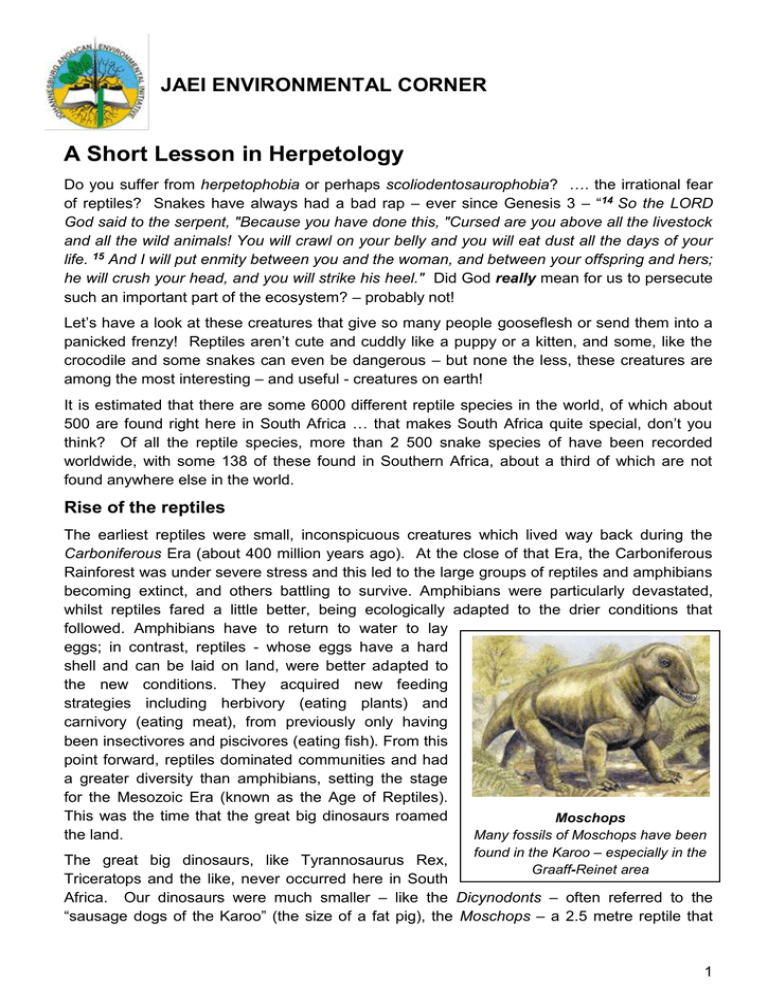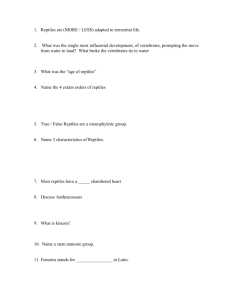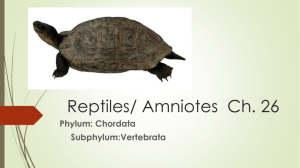JAEI ENVIRONMENTAL CORNER A Short Lesson in Herpetology
advertisement

JAEI ENVIRONMENTAL CORNER A Short Lesson in Herpetology Do you suffer from herpetophobia or perhaps scoliodentosaurophobia? …. the irrational fear of reptiles? Snakes have always had a bad rap – ever since Genesis 3 – “14 So the LORD God said to the serpent, "Because you have done this, "Cursed are you above all the livestock and all the wild animals! You will crawl on your belly and you will eat dust all the days of your life. 15 And I will put enmity between you and the woman, and between your offspring and hers; he will crush your head, and you will strike his heel." Did God really mean for us to persecute such an important part of the ecosystem? – probably not! Let’s have a look at these creatures that give so many people gooseflesh or send them into a panicked frenzy! Reptiles aren’t cute and cuddly like a puppy or a kitten, and some, like the crocodile and some snakes can even be dangerous – but none the less, these creatures are among the most interesting – and useful - creatures on earth! It is estimated that there are some 6000 different reptile species in the world, of which about 500 are found right here in South Africa … that makes South Africa quite special, don’t you think? Of all the reptile species, more than 2 500 snake species of have been recorded worldwide, with some 138 of these found in Southern Africa, about a third of which are not found anywhere else in the world. Rise of the reptiles The earliest reptiles were small, inconspicuous creatures which lived way back during the Carboniferous Era (about 400 million years ago). At the close of that Era, the Carboniferous Rainforest was under severe stress and this led to the large groups of reptiles and amphibians becoming extinct, and others battling to survive. Amphibians were particularly devastated, whilst reptiles fared a little better, being ecologically adapted to the drier conditions that followed. Amphibians have to return to water to lay eggs; in contrast, reptiles - whose eggs have a hard shell and can be laid on land, were better adapted to the new conditions. They acquired new feeding strategies including herbivory (eating plants) and carnivory (eating meat), from previously only having been insectivores and piscivores (eating fish). From this point forward, reptiles dominated communities and had a greater diversity than amphibians, setting the stage for the Mesozoic Era (known as the Age of Reptiles). This was the time that the great big dinosaurs roamed Moschops the land. Many fossils of Moschops have been found in the Karoo – especially in the The great big dinosaurs, like Tyrannosaurus Rex, Graaff-Reinet area Triceratops and the like, never occurred here in South Africa. Our dinosaurs were much smaller – like the Dicynodonts – often referred to the “sausage dogs of the Karoo” (the size of a fat pig), the Moschops – a 2.5 metre reptile that 1 looked like a lizard on steroids! and the plant-eating Massospondylus which was about 6 metres with long neck. This dinosaur actually makes up the greatest number of dinosaur fossils found in southern Arica. The dinosaurs of southern Africa didn’t make the sudden exit from the Planet like their much bigger cousins of warmer climes, but gradually evolved into other reptiles which were more adaptable to the changing climate. What is a Reptile? The word “reptile” is derived from the Latin word repere which means “crawl” … perhaps not the best description, as most reptiles don’t crawl! Snakes don’t have legs and have to slither along, tortoises amble along and many lizards can run as fast as lightening! Reptiles are wonderfully diverse in size, shape, colour, and lifestyle. Reptiles, as we have seen, have a long history; having lived on earth for more than 350 million years. Reptiles are mysterious, fascinating and incredibly useful, but sadly often misunderstood and feared. The reptiles, or Class Reptilia, include tortoises, turtles, crocodiles, chameleons, lizards and snakes. There are around 6,000 living reptile species (dinosaurs are among the many extinct types of reptiles), and while they prefer warmer climates, reptiles can be found all over the world. Most reptile babies develop in eggs with a hard outer shell that have been laid by the female (these are called ovoviviparous – Pythons, cobras, etc are ovoviviparous); a few develop in eggs within the mother's body and the babies are actually born (called viviparous – most adders are viviparous.) A few facts …… Reptiles are vertebrates - they have an internal skeleton with a backbone. Reptiles are tetrapods - they have four legs or their ancestors had four legs. (Even snakes, whose legs have been lost, are tetrapods.) Reptiles have scales, shields, or plates covering their bodies for protection. All reptiles (apart from crocodiles) shed their skin from time to time or form new layers to replace the old skin. Reptiles are amniotes - they have eggs with a waterproof shell that contains amniotic fluid. Reptiles are ectotherms or cold-blooded - they use their environment to warm and cool their bodies. This is why you’ll see crocodiles or other reptiles basking in the sun – they need to do this to keep their bodies warm. (Mammals and birds are endotherms or “warm-blooded”, we keep our bodies warm from what we eat.) Reptiles range in size from a tiny geckoes and Brookesia micra – of Madagascar chameleons (the smallest chameleon in the world is found in Madagascar and measures just 1.5cm!), to the enormous crocodile, which may reach 6 m in length and weigh over 1,000 kg. The study of reptiles is called herpetology. The world’s smallest chameleon - 2 Reptiles evolved as land-dwelling creatures - they have skin that protects them from drying out, and toes with claws. Some reptiles later adapted to life in the water; others took to the air. (Believe it or not, birds are descended from reptiles!) Some people say that snakes and lizards are wet and slimy. Actually, this is not true reptiles don’t have sweat and fat glands, so their skin is dry and not slimy at all. Interesting snippets When is a snake not a snake? Some lizards, such as the Burrowing Skink, have lost their limbs as they are adapted to an underground existence, burrowing through soft soil in search of their food of ants, termites and other small creatures. Legs would be a hindrance underground, so some species have lost their legs altogether and look very “snake-like”. Some species of girdled lizards have also developed a snake-like appearance. These lizards have tiny legs and very long tails and “swim” through the grass with speed and grace. Is the Chameleon’s tongue sticky? Actually, no! Although it is commonly thought that it is, this is not true. The tip of the tongue is a moist, rounded area of soft tissue which acts like a suction cup. When the tongue shoots out, this “suction cup” wraps around the unlucky insect with enough force to drag it from its perch. The tongue then springs back into the chameleon’s mouth like a spring and the insect is chomped! Does a snake’s tongue contain a poisonous sting? Nope! A snake’s forked tongue is in fact a very delicate and sensitive instrument used to gather smells from its environment. A snake can’t see very well, nor can it smell with its nostrils, so uses its moist tongue to collect scent particles instead. These particles are transferred back to the snake’s mouth and analysed by a special organ in the roof of the mount called Jacobson’s organ. A snake doesn’t need to open its mouth to dart its tongue in and out – there is a small notch in the lip trough which the slender tongue can easily pass. What is the difference between turtles, tortoises and terrapins? Many people are confused between these reptiles – so here is an explanation of who’s who in the zoo! Leatherback Turtle. Turtles – these reptiles are ocean Largest turtle in the world whose breeding is dwelling. These include the great closely monitored on the beaches of Leatherback turtle (the largest turtle in the northern KwaZulu Natal world) which graces our Northern KZN shores in order to lay their eggs. Turtles eat seaweed but also enjoy a jellyfish when the opportunity arises. 3 Tortoises – these are the land-living tortoises that we see ambling along in the veld. These include the leopard tortoise and the highly endangered geometric tortoise. Did you know that the Speckled Padloper tortoise of Namaqualand is the smallest tortoise in the world being only 8cm fully grown? All tortoises are herbivores – they munch plants. Tortoises can pull their heads into their shells and cover the opening with their tough horny legs for protection when needed. Please remember that it is totally illegal to keep a tortoise as a pet without a permit! … Leave the poor creatures in the veld where they are happy! Terrapins – these live in fresh-water. These terrapins are those that you see sunning themselves on logs or river banks. Terrapins can only pull their necks in sideways so that the head and one eye is always visible. Some terrapins have a hinged lowers shell which they can pull up like a drawbridge to protect its head completely. Terrapins are carnivorous (they eat meat) and often lay in wait to catch the unsuspecting dove that comes to have a drink. The alien red-headed terrapin, which hails from South America, has been illegally released into our dams and waterways which are causing major problems with our indigenous environment. NEVER release any unwanted “pet” into the environment – you never know what trouble you are going to cause! … and so, know you know! Can a chameleon change colour to match its background? Not really. A chameleon’s ‘normal’ colour is an adaptation to its ‘normal’ background and it is certainly a master of camouflage. You can’t expect a normally green chameleon to turn red or blue if you plonk it on a red or blue cloth and it certainly won’t turn tartan if you plonk it onto a Scottish kilt! Its colour change depends on temperature, the amount of sunlight and its emotions. At night, a sleeping chameleon is very pale – almost white – and if you go into the bush at night with a torch you are bound to see one dozing at the end of branch. A male in the mating season will be very brightly coloured, and an angry chameleon is black! How can snakes eat prey larger than their mouths? Snakes cannot chew or break up their food like most other animals and have had to develop their own way of coping with large food items. Firstly, their mouths have a very wide gape and secondly, the jawbones (two above and two below) are not fixed together but are loosely attached to each other and movable. Thirdly, the jaw-bones are held together in the middle by elastic ligaments Python consuming an impala and muscles which can be stretched enormously. A python can, in fact, swallow a full-grown impala! 4 Are any lizards poisonous? Yes, but not in Africa. Of the 3800 species of lizards, only two are poisonous – one in Mexico (Mexican beaded lizard) and the other in the south-western United States (the Gila monster). Our South African lizards are totally harmless and very handy in keeping the numbers of goggas at acceptable levels. Which snake is the farmer’s friend? The mole-snake. This large snake is one of our most useful snakes as it feeds on moles, mole-rats, rats and other animals which are a nuisance in farmlands. The mole-snake is a constrictor and is NOT venomous. Unfortunately it is often killed by people who mistake it for a cobra. How does a gecko walk upside down? Many geckos can not only run up a vertical wall with ease, but can also walk upside down on ceilings. The secret of this amazing skill lies in the pads on the underside of the gecko’s toes. Each toe-tip has a group of overlapping plates, rather like the strips in a louvre window. These plates have many tiny, branched hairs which can only be seen under a microscope. The hairs hook into minute cracks and projections on whatever it is climbing or running on. Is a dead cobra or rinkhals safe to touch? Not necessarily, because some cobras and the rinkhals will both pretend to be dead in an emergency. If a rinkhals sees no means of escape, it will roll over limply on its back with its mouth wide open and allow itself to be picked up without reacting. But if the opportunity arises, it will give its enemy a venomous bite to remember! Identifying snakes 35 of the species found in southern Africa are venomous and believe it or not, only eight of South Africa's snake species are highly venomous and pose a real danger to us. However, if you are not well-versed in snake identification, treat all snakes with caution. DON’T KILL THEM!!!!!! Snakes are such an important part of the ecosystem. The venomous snakes that we need to be wary of are the cobras (includes the rinkhals) the adders and the mambas. The black mamba is the most venomous and dangerous snake in South Africa, with the Gaboon viper/adder and Mozambique spitting cobra a close second. By the way, a black mamba is not black – rather a dark slaty-grey. The “black” comes from the colour of the inside of its mouth. (And yes, the black mamba is not longer just found in warm The Black Mamba 5 climes like the Lowveld and KZN – it is now also found in Gauteng!) Pythons are dangerous only because of their size – they are constrictors and do not have venom. When you see a snake, observe its colour, length, the shape of its head, and its posture. If it rears up like a rinkhals, cobra and coral snake, flattens its neck to form hood, it will be more inclined to strike than slink away. Pythons and adders move forwards in a straight line, other snakes move in a series of side-to-side undulations. If you come across a snake, FREEZE! – don’t turn and run! Stand absolutely still – snakes don’t have the best eyesight in the world, but do see and feel the vibrations of movement. The snake will then more than likely go on its merry way. If it doesn’t, in the slowest “slo-mo” that you can muster, move back VERY SLOWLY. At the same time, SLOWLY bring your hand up to your face and SLOWLY turn your face away in order to protect your eyes (in case it is a snake that sprays venom.) Once you have put at least 5 meters between you and the snake, only then can you turn and run, faint, or scream! Let’s all remember that REPTILES are a VERY important part of our environment, and each has its own special job to do. The needless killing of these amazing creatures is so unnecessary - so don’t ever be tempted to send them to reptile heaven – even if you are terrified. Remember, these poor creatures are more terrified of YOU! Prayer of St Basil the Great O God, enlarge within us the sense of fellowship with all living things, for our brothers and sisters, the inarticulate beasts, to whom Thou gave the earth as their home in common with us. We remember with shame that in the past we have exercised the high dominion of humanity with ruthless cruelty so that the voice of the earth, which should have gone up to thee in song has become a groan of anguish and a cry of torment. May we realize that they live not for us alone, but for themselves and for Thee, and that they too love the sweetness of life. Amen. “Pleasssse care for me, I’m not as bad as you think!” 6






